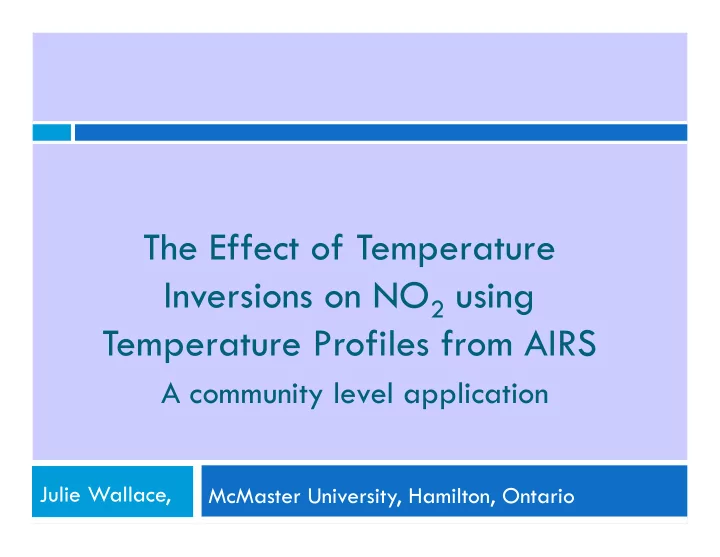

The Effect of Temperature Inversions on NO 2 using Temperature Profiles from AIRS A community level application Julie Wallace, McMaster University, Hamilton, Ontario
Study Area Temperature Inversions in Hamilton AIRS data from GIOVANNI L. Ontario Hamilton Results and Application L. Erie Source: Google Maps
Rationale - Health Concerns Population of Hamilton 500,000 Industry + traffic => poor air quality Inversions occur frequently Respiratory diseases – common Asthma Coughs
Temperature Inversions Nighttime radiation inversions most common Daytime – advective, subsidence Surface or elevated Elevated – recirculation of pollution progressively increasing the pollutant loading over time
Niagara Escarpment Influenced by Niagara Niagara Escarpment Escarpment L. Ontario Proximity to L. Erie Great Lakes Source: Google Maps
Topography Industry
Inversion – October 13, 2008 John Brannan 2008
Determining Temperature Profiles Local meteorological tower, 91 m high Nearest WMO Radiosonde Station at Buffalo International Airport -100 km south 3 air quality monitors Met. Tower
AIRS Data from GIOVANNI Ease of download and ease of use Minimal processing Limitations in horizontal and vertical resolution AIRS Level 3, version 5 , daily AM/PM temperature profiles 2003-2007 (1826 days)
AIRS Data Temperature profiles up to 925 hPa level PM Crossing AM Crossing 1450 valid PM profiles 1436 valid profiles Normal Inversion Normal Inversion 1120 330 1000 436 Strength of inversions Day: 2.8 C Night: 2.4 C
Inversion Frequency
Results - NO 2 DAYTIME LOCAL – 48% increase AIRS – 11% increase
NO 2 - NIGHTTIME LOCAL – 40% increase AIRS – 49% increase
SEASONAL NO 2 - DAY LOCAL AIRS
SEASONAL NO 2 - NIGHT LOCAL AIRS
Wind Direction – AIRS Daytime Normal Inversion Long-range transport
Wind Direction - Nighttime Normal Inversion
Health Impact Human Respiratory Response Neutrophil cell types in respiratory tract Respond to infection and inflammation count increases after exposure to air pollution
Human Respiratory Response
Multivariate Statistical Regression Coefficients a Unstandardized 95.0% Confidence Coefficients Interval for B Lower Upper Model B Std. Error t Sig. Bound Bound Day Inversion .124 .049 2.516 .012 .027 .221 a. Dependent Variable: Neutrophil Counts ArcSin Transformation Controlling for age, smoking, medication, surface temperature, humidity
Conclusions AIRS temperature profiles useful in assessing changes in air quality resulting from inversions Suitable for studies of the city and neighboring areas Can be incorporated into health studies
References Dragonieri S, Musti M, Izzo C, et al. Sputum induced cellularity in a group of traffic policemen. Sci Total Environ 2006; 367: 433-6. Bosson J, Barath S, Pourazar J,et al. Diesel exhaust exposure enhances the ozone- induced airway inflammation in healthy humans. Eur Respir J 2008; 31: 1234-40.
Daytime Frequency Night Day
PM2.5 AIRS DAY NIGHT
PM2.5 MT DAY NIGHT
PM2.5 WIND DIRECTION
Validation
Recommend
More recommend